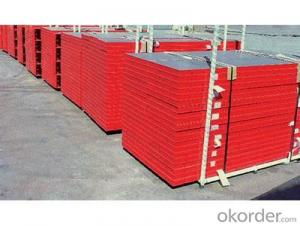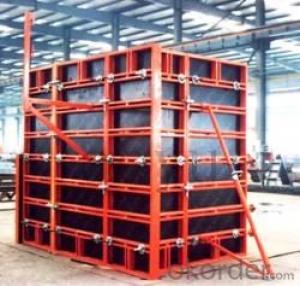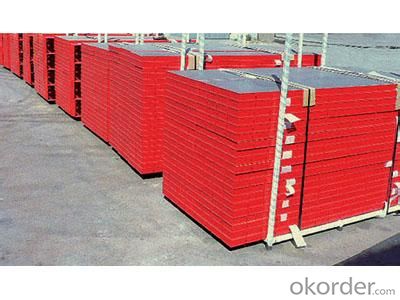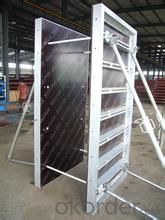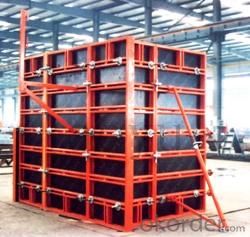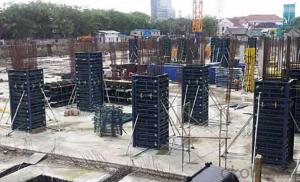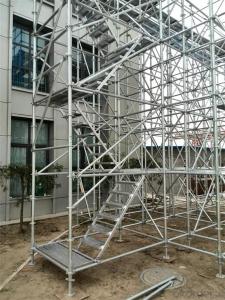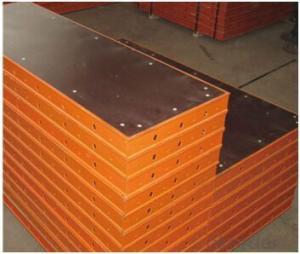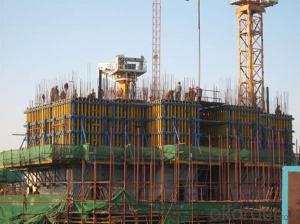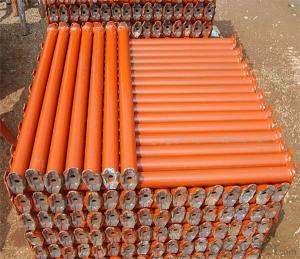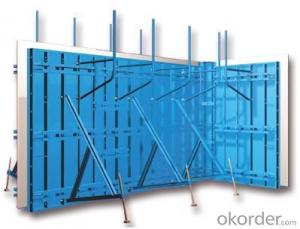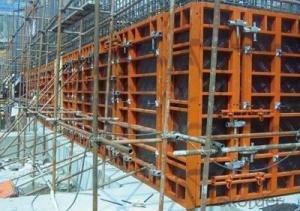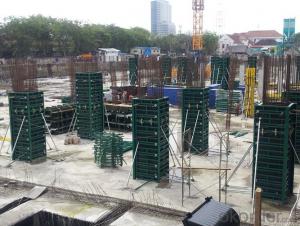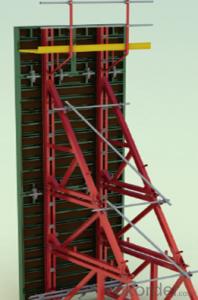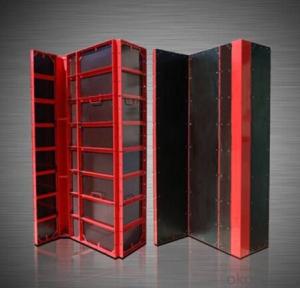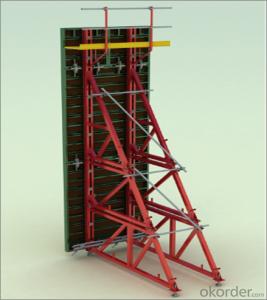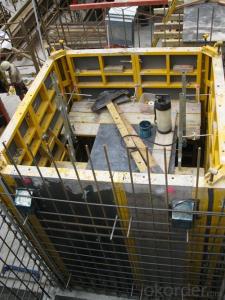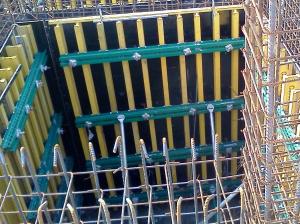120 Steel Frame Formworks for All Kinds of Construction
- Loading Port:
- Shanghai
- Payment Terms:
- TT OR LC
- Min Order Qty:
- 1000 m²
- Supply Capability:
- 100000 m²/month
OKorder Service Pledge
OKorder Financial Service
You Might Also Like
1. Structure of Steel Frame Formwork GK120 Description
There is a prizing part designed in the corner, which can help to position and remove formwork easily.The plywood is screwed on from the back when connecting frame and plywood, so the surface of the finished concrete is perfect.The formwork series are a complete system with a full set of accessories, and can be set up flexibly according to project demand.
2. Main Features of Steel Frame Formwork GK120
-convenient for construction
-easy to control the quality
-easy, rapid and economical.
3. Steel Frame Formwork GK120 Images
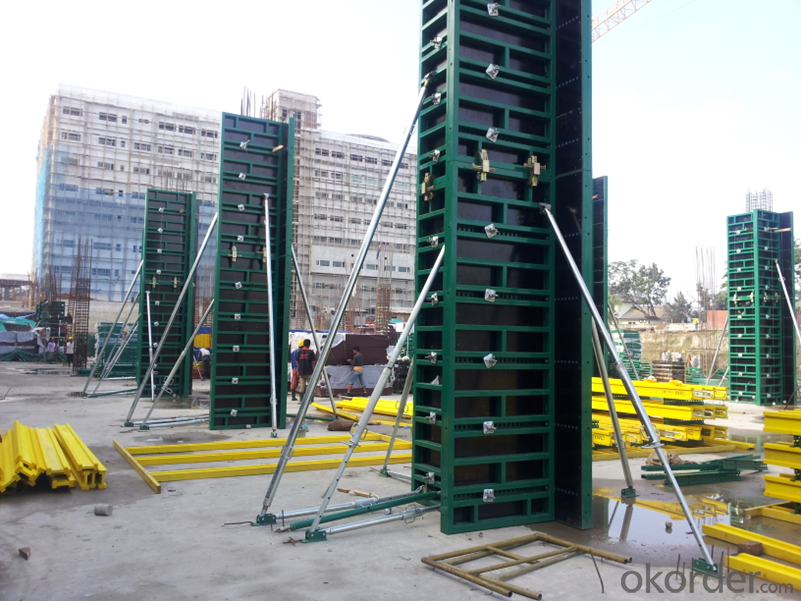
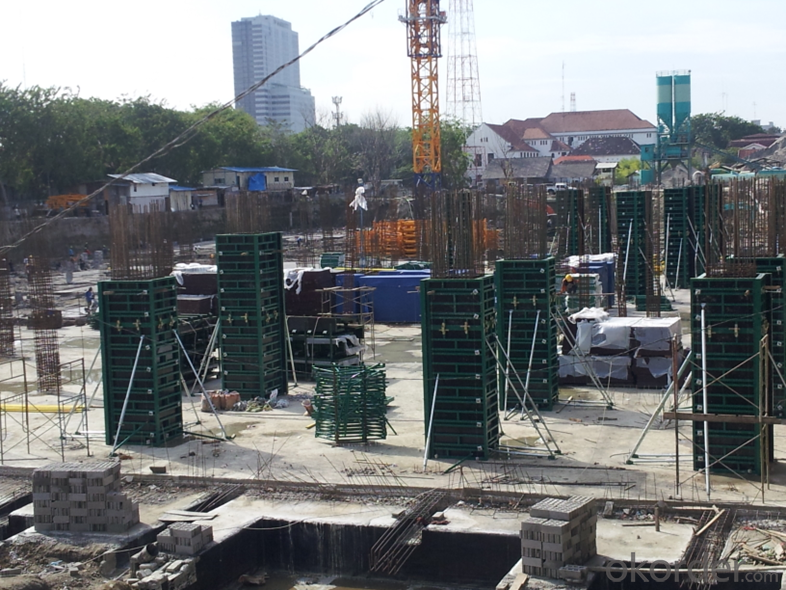
4. Steel Frame Formwork GK120Specifications
Steel Frame Formwork GK120 is used for the concrete pouring of square or rectangle column. The system has the same structure and similar connection type with wall formwork.
5.Steel Frame Formwork GK120
1) What can we do for you?
.We can ensure the quality of the Steel Frame Formwork GK120 and avoid extra expenses for customers.
.We can provide you the professional technical team.
.We can provide professional building proposal for your projects.
2) What promises can be done by us?
. If interested in this kind of formwork, please feel free to write us for any QUOTE.
. If need any technical and building assistance, we could provide on-site professional staff for instruction.
. Please DO check goods when courier knocks your door and contact us asap if any issueS.
3) What about of our after-sale services?
. Response will be carried out in 24hours after receiving any complain or request.
. Any formwork cost can be refund after order is confirmed.
. If the products are not based on the requirements, there will be the relevant compensations made for you.
4) What about the package and shipping time?
.Packing: wood package and adhesive tape
.Shipping: by sea
Shipping time: Normally small orders, it just1week business days to arrive your hand; When comes to the customs declaration, it may need 2weeks.
- Q: What are the key safety features of steel frame formwork?
- The key safety features of steel frame formwork include: 1. Durability: Steel is a strong and sturdy material that can withstand heavy loads and external forces, ensuring the safety of workers and the structure itself. 2. Stability: The steel frame formwork system provides excellent stability due to its rigid structure. It can resist shifting or collapsing during concrete pouring, minimizing the risk of accidents. 3. Easy assembly and disassembly: Steel frame formwork is designed for quick and easy installation and removal. The components can be easily connected and disconnected, reducing the time workers spend on the construction site and minimizing the chances of accidents. 4. Adjustable design: Steel frame formwork systems often feature adjustable components, such as telescopic props and adjustable brackets. This allows for precise positioning and alignment, ensuring the formwork is secure and stable. 5. Safety accessories: Steel frame formwork is often equipped with safety accessories such as handrails, toe boards, and safety nets. These accessories provide additional protection for workers, preventing falls and injuries. 6. Fire resistance: Steel is a non-combustible material, making steel frame formwork highly resistant to fire. This feature enhances the overall safety of the construction site and reduces the risk of fire-related accidents. 7. Load-bearing capacity: Steel frame formwork is designed to withstand heavy loads, ensuring the safety of workers and preventing any structural failures. This feature is particularly important in high-rise constructions or projects with significant load requirements. 8. Compatibility with other safety systems: Steel frame formwork can be easily integrated with other safety systems, such as scaffolding or fall protection equipment. This ensures a comprehensive safety setup on the construction site, reducing the risk of accidents and injuries. Overall, the key safety features of steel frame formwork make it a reliable and secure option for construction projects. Its durability, stability, easy assembly, adjustable design, safety accessories, fire resistance, load-bearing capacity, and compatibility with other safety systems all contribute to creating a safe working environment for construction workers.
- Q: What types of concrete structures can be built using steel frame formwork?
- A wide array of concrete structures can be built using steel frame formwork. Here are some notable examples: 1. Tall buildings: When constructing skyscrapers, steel frame formwork is frequently employed due to its robustness and stability. It can be easily assembled and disassembled, thus making it suitable for multiple floors. 2. Bridges and flyovers: Thanks to its capacity to bear heavy loads, steel frame formwork is ideal for constructing bridges and flyovers. It can be tailored to match the specific shape and size requirements of the structure. 3. Industrial edifices: Steel frame formwork is commonly utilized in constructing industrial buildings like factories, warehouses, and power plants. Its versatility enables the creation of expansive, open spaces capable of housing machinery and equipment. 4. Residential constructions: Steel frame formwork is adaptable for constructing residential buildings of varying sizes and designs. It provides layout flexibility and can withstand the weight of multiple floors. 5. Commercial complexes: Constructing commercial complexes, such as shopping malls, office buildings, and hotels, is an ideal application for steel frame formwork. It can accommodate diverse architectural styles and the integration of various amenities. 6. Stadiums and sports facilities: Due to its ability to create spacious, open areas, steel frame formwork is commonly employed in the construction of sports facilities. It can support the weight of spectator seating and provide the necessary structural integrity. In summary, steel frame formwork is a versatile construction technique that can be utilized to build a broad range of concrete structures, from towering buildings to bridges and industrial facilities. Its strength, stability, and flexibility make it a favored choice in the construction industry.
- Q: How does steel frame formwork accommodate for different concrete mix proportions?
- Steel frame formwork is a versatile and adaptable solution for accommodating different concrete mix proportions. This is primarily due to the inherent flexibility and adjustability of the steel frames, which can be easily modified and customized to suit specific mix designs. One way steel frame formwork accommodates for different concrete mix proportions is through the use of adjustable panels. These panels can be repositioned or removed to create varying heights and shapes required for different concrete structures. By adjusting the formwork panels, contractors can create molds that allow for the desired amount and consistency of concrete to be poured. Furthermore, steel frame formwork also offers the advantage of being able to withstand the pressure exerted by different concrete mix proportions. The strength and rigidity of steel frames allow them to support the weight and pressure of heavier or more fluid concrete mixes without deforming or collapsing. This ensures that the formwork remains stable during the pouring and curing process, resulting in a structurally sound and durable concrete structure. Additionally, steel frame formwork can be easily reinforced or braced to accommodate for varying concrete mix proportions. Reinforcements such as additional steel bars or braces can be added to the formwork system to provide extra support and stability when dealing with higher strength or more fluid concrete mixes. This ensures that the formwork can withstand the added pressure and prevents any potential deformation or failure. Overall, steel frame formwork provides a flexible and adaptable solution for accommodating different concrete mix proportions. Its adjustable panels, strength, and ability to be reinforced allow contractors to create molds that can accommodate various mix designs, ensuring the successful construction of a wide range of concrete structures.
- Q: Is the bamboo plywood and wood plywood the same?
- Because of the high hardness of bamboo, with fixed drill drilling needs. Therefore, wood template is more simple and convenient. Hope to help you.
- Q: How does steel frame formwork accommodate for different concrete test requirements?
- Steel frame formwork is a versatile and adaptable system that can easily accommodate different concrete test requirements. This is primarily due to its modular nature and adjustable components. Firstly, steel frame formwork allows for the creation of various shapes and sizes of concrete structures. The steel frames can be easily assembled and disassembled to form different configurations, allowing for flexibility in accommodating different concrete test requirements. Whether it is a simple slab or a complex column or wall, the steel formwork can be adjusted to meet the specific dimensions and design requirements. Additionally, steel frame formwork enables the adjustment of concrete test requirements through its adjustable components. The formwork system includes adjustable vertical and horizontal supports, as well as adjustable brackets and props. These components can be easily moved, adjusted, and aligned to accommodate the necessary concrete test requirements, such as different heights, thicknesses, or angles. Furthermore, steel frame formwork provides the flexibility to incorporate various form liners, inserts, or accessories according to the specific concrete test requirements. These can include inserts for creating specific surface finishes, form liners for decorative patterns, or additional accessories for reinforcing or strengthening the concrete structure. The steel formwork system can be customized and adapted to include these elements, ensuring that the concrete test requirements are met. Overall, steel frame formwork is a highly adaptable system that can easily accommodate different concrete test requirements. Its modular nature, adjustable components, and ability to incorporate various accessories make it a versatile choice for various construction projects.
- Q: How does steel frame formwork compare to other formwork systems in terms of durability?
- Steel frame formwork is known for its exceptional durability compared to other formwork systems. The steel construction provides excellent strength and stability, allowing it to withstand heavy loads and harsh weather conditions. This durability ensures that the formwork system can be used repeatedly without compromising its structural integrity, making it a cost-effective choice in the long run. Additionally, steel frame formwork is highly resistant to wear and tear, ensuring its longevity and minimizing the need for frequent repairs or replacements. Overall, steel frame formwork surpasses other systems in terms of durability, making it a reliable and efficient choice for construction projects.
- Q: Are there any limitations to the size or shape of structures that can be constructed using steel frame formwork?
- Steel frame formwork has limitations in terms of the size and shape of structures that can be constructed. Although it is a versatile construction method, there are certain constraints to consider. Firstly, the size of the steel frames themselves is a limitation. These frames come in standard sizes and dimensions, and the structure being built must adhere to these specifications. If a project requires non-standard dimensions, customization or modifications may be necessary, resulting in increased costs and construction time. Moreover, the weight-bearing capacity of the steel frame formwork is another limitation. The steel frames have a maximum load capacity that must be respected to ensure structural integrity and safety. Depending on the design and purpose of the structure, as well as the weight of the materials used and the expected loads, the size and spacing of the steel frames may need to be adjusted accordingly. Additionally, the shape of the structure is a factor that limits the use of steel frame formwork. This construction method is well-suited for rectangular or square structures, as it can easily accommodate straight lines and right angles. However, if a project requires complex or irregular shapes, additional measures such as custom-made formwork or extra support structures may be necessary to achieve the desired design. To sum up, steel frame formwork has its advantages in construction, but it is important to consider the limitations in terms of the size and shape of structures that can be built using this method. These limitations arise from the standard sizes and load-bearing capacity of the steel frames, as well as the challenges in accommodating unconventional dimensions or complex shapes.
- Q: Can steel frame formwork be used for both above-grade and below-grade concrete structures?
- Steel frame formwork is suitable for both above-grade and below-grade concrete structures. Its versatility and flexibility allow it to be tailored to meet different project needs. This formwork provides a sturdy and inflexible support system for pouring and shaping concrete, guaranteeing precise and accurate construction. Its reliability makes it a dependable option for constructing buildings, bridges, basements, and tunnels. It can withstand the pressure of the concrete while ensuring a secure and stable construction process.
- Q: What are the safety precautions for storing steel frame formwork?
- The safety precautions for storing steel frame formwork include ensuring the frames are properly stacked and secured to prevent them from toppling over, storing them in a designated area away from high traffic zones, keeping them protected from weather elements to prevent rust and corrosion, inspecting them regularly for any damage or defects, and following any specific manufacturer guidelines for storage.
- Q: How does steel frame formwork affect the overall constructability of a concrete structure?
- Steel frame formwork can greatly enhance the overall constructability of a concrete structure. This type of formwork system consists of steel frames, usually made from steel beams or columns, which are used to support the weight of the concrete during the pouring and curing process. One of the main advantages of steel frame formwork is its strength and durability. Steel is known for its high load-bearing capacity, allowing the formwork to withstand the pressure exerted by the wet concrete. This means that larger and taller concrete structures can be easily constructed using steel frame formwork, as it provides the necessary support and stability. Additionally, steel frame formwork offers versatility in terms of design and layout. The modular nature of the steel frames allows for easy assembly and disassembly, making it suitable for various types of structures. This adaptability is especially beneficial when working on projects with complex shapes or irregular layouts, as the formwork can be customized to match the specific requirements. Furthermore, steel frame formwork enables faster construction times. The reusable nature of the steel frames means that they can be easily transported and reassembled at different locations, reducing the need for new formwork materials. This not only saves time but also reduces construction costs. Additionally, the smooth surface of steel formwork allows for faster and easier concrete pouring and finishing, resulting in shorter construction schedules. Another advantage of steel frame formwork is its ability to improve the quality of the concrete structure. The rigid steel frames ensure accurate alignment and dimensions, reducing the risk of any deformities or inconsistencies in the final structure. This helps to achieve better overall aesthetics and structural integrity. In summary, steel frame formwork positively impacts the overall constructability of a concrete structure by providing strength, durability, versatility, speed, and improved quality. Its ability to support larger and complex structures, along with its ease of assembly and reusability, make it a preferred choice for many construction projects.
Send your message to us
120 Steel Frame Formworks for All Kinds of Construction
- Loading Port:
- Shanghai
- Payment Terms:
- TT OR LC
- Min Order Qty:
- 1000 m²
- Supply Capability:
- 100000 m²/month
OKorder Service Pledge
OKorder Financial Service
Similar products
Hot products
Hot Searches
